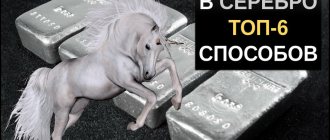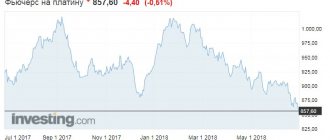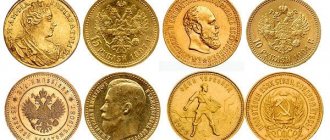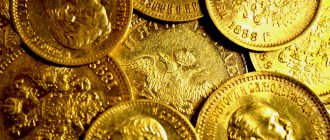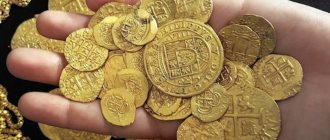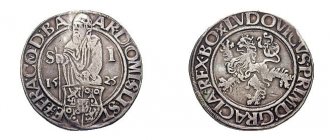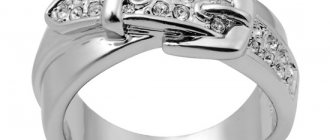Precious metals confirmed their reputation as reliable assets, rising in price to new highs. According to experts, the trend will decline.
The rise in value was caused by both economic concerns and political events. And since stabilization is expected, there are no reasons for a strong rise in prices.
Do you want to make money on stocks? Subscribe to the Telegram bot @birzevikbot - it sends out stock exchange news, trends, lectures - I recommend it to both beginners and professionals.
Instability in the market quite predictably leads to the fact that more and more people want to invest in historically proven values on the market. And stability allows you to look for riskier assets.
Over the past few years, the Central Bank of Russia has been regularly and methodically replenishing its gold reserves. According to analysts, this is a kind of “insurance” against stock market instability. During stock market surges, the price of gold and silver rises because... they are protected assets that do not depreciate. Instability in the foreign exchange market can only please the owners of untouchable metals, but it will also mean that the overall economic situation is in decline.
The price of gold will be affected by two important multidirectional factors. A stronger US currency will put pressure on gold, but increasing political instability and demand for populism around the world, especially in developed countries, will push investors towards the safe-haven asset.
Short-term forecasts for metals for a month in advance (based on monthly dynamics). Gold 3928.7132098352 Silver 72.281095646545 Platinum 3141.5062243562 Palladium 5674.7814148889
The opinions of authoritative analysts on this issue are cautious and contradictory.
American analysts are optimistic and believe that the cost of gold will increase, but not significantly, even despite the increase in imports of this metal from China.
European colleagues believe that the price has reached its maximum, and the period of growth will be replaced by stability or will decrease slightly, the basis is the strong influence of the decisions of the Federal Reserve System regarding interest rates.
Russia and China have long been looking for ways to get rid of dollar dependence, and this will leave its mark.
Analysts recommend investing in gold for those who intend to save their savings; for those who want to increase them, it is better to invest in currency.
Since the beginning of 2013, gold has noticeably lost in value. But it seems that the situation is changing. The global economy is unstable, so gold is again becoming an attractive investment. There is an opinion that banks will begin to increase the share of gold in their reserves, which means the price of gold will rise (banks in China, Japan and Saudi Arabia are already actively buying gold).
Additionally: what affects the price of gold.
Gold is a risky investment item for preserving capital. The change in the price of gold today reaches more than 1% per month or 20% per year. So the price of the precious metal could fall and you could lose a fifth of your investment in just a year. At the same time, the largest Swiss banks offer clients deposits with rates of 3-4% per annum. And government bonds issued by the United States for 10 years offer 2-3% yield per annum. This way, at least you won't lose what you already have.
Important: general economic forecast for the year , forecasts for dollar, euro, ruble exchange rates.
On the state of the global silver market – Metals Focus
Translation of the main provisions of the report prepared by order of the Silver Institute.
Basically, the price dynamics of most commodities is determined by their supply and demand. Investors view these indicators either in the context of long-term trends or the impact of specific significant events. All of the above is quite true for the platinum group metals, but not for silver and gold, due to their functioning as quasi-money. The prices of these monetary metals depend on macroeconomic factors (such as changes in interest rates or the outlook for stock markets), as well as on the perception of specific factors by investors.
In turn, silver has several specific features. Firstly, the price of this precious metal can be affected by the state of industrial metals, in particular copper. Due to the fact that silver is mostly used in industry. Thus, in 2018, industry accounted for 52% of the demand for gray metal. Secondly, the silver market is not very liquid. The story of the Hunt brothers, in the 1979-1980s. who bought 1/3 of silver to manipulate its market is proof of this. Agree, this is unlikely to happen with gold. Third, the price of silver tends to be more volatile than gold. However, even though the gray metal successfully functions as a medium of exchange and store of value, only gold can closely resemble actual money, which means it is more strongly influenced by macroeconomic data.
The following will be an analysis of the following aspects of the silver market:
the degree to which silver is affected by rates of other commodities;
macroeconomic factors of paramount importance for precious metals in general, and for silver in particular;
the influence of supply and demand on the price of silver is direct and indirect (through investor sentiment).
Correlation of Silver with Other Commodities
Silver prices primarily depend on the prices of other commodities, in particular gold. It is worth noting that since the mid-2000s. the price correlation between these two metals is at a relatively stable level of about 0.8 points (a positive correlation indicating both markets are moving in the same direction). However, this indicator tells us little about the reason for gold's dominance. Thus, according to Metals Focus calculations, the volume of all forms of investment in gold in 2021 amounted to more than $45 billion, and in silver less than $3 billion.
The price of oil can have a serious impact on the prices of precious metals. The correlation sometimes exceeds 0.5, but according to Metals Focus analysts, the connection between these assets is not direct. Yet gold often moves in the same direction as oil, as both assets are affected by geopolitical events (for example, attacks on oil tankers in the Persian Gulf). In addition, a high oil price may trigger a slowdown in global economic development, which will have a positive impact on defensive assets, such as gold. In such cases, the price of silver rises along with the rise in price of the yellow metal, thereby creating the impression of a direct connection between the gray metal and black gold.
In most cases, tying the price of silver to gold masks the impact of base metal prices on the gray metal. But the correlation of the latter with the silver rate can be significant – from 0.5 and higher. This is not surprising, since industrial demand for silver accounts for more than 50% of the total demand for this precious metal. Silver is often considered in tandem with copper, both metals being used for the same industrial processes. For example, copper is an essential element of electrical/electronic equipment, unlike steel and lead. However, there is no direct evidence that copper is more highly correlated with silver than the all base metal baskets.
At the 250-day yield level, silver has a higher correlation with gold. If we take a shorter period of time (for example, 20-day returns), then the correlation for industrial metals can be much stronger than gold. However, according to Metals Focus research, since the beginning of 2001, such a correlation has been observed on less than 3% of trading days. It's also worth emphasizing that while industrial demand for silver has been king in recent years, the correlation with gold remains high. But the correlation with base metal prices is volatile: by the beginning of 2021, it was below 0.2 for almost the entire year.
It's worth considering other factors to explain fluctuations in the gold-silver ratio.
The ratio is currently near a multi-year high amid an upward trend that has continued since 2011. This is largely due to falling base metal prices, as well as the recent decline in purchases of silver bars and coins. Some experts believe that as macroeconomic conditions deteriorate, the gold-silver ratio increases and a true crisis is needed for silver to begin to catch up with gold.
Macroeconomic Variables
Given the above situation with the correlation of the silver rate with gold and industrial metals, it is not surprising that it may be influenced by similar macroeconomic factors.
The state of the precious metals markets is currently driven primarily by the escalation of the trade war between the United States and China, and their attention is focused on the likely impact of this event on economic growth not only in the United States and China, but throughout the world. Predictions about the scale of potential damage from this war have already seen investors rushing to buy defensive assets, which has benefited gold and, more recently, silver as well. This fact is a consequence of investor concerns about the impact of GDP and industrial production on the silver market. However, this influence may not be so strong, since other macroeconomic variables encourage investors, even against the backdrop of news of worsening GDP growth, to buy gold, followed by silver. Bad news about the global economy could also be negative for industrial metals, and therefore silver.
The reason for this uncertainty is the US dollar index, since the price of silver is denominated in that currency. Thus, news that supports the dollar or damages it immediately changes exchange rates, as well as the rate of the precious metal in US dollars, but at the same time leaving its price in other currencies practically unchanged. For example, the decline in the dollar value of silver from the 2011 high to the 2015 low was driven by the rise of the US currency. In addition, data on exchange rates and GDP are linked to interest rates. Thus, the latter can directly affect precious metals: changes in rates increase or decrease the opportunity costs of owning them, which is a significant factor for assets that do not generate interest income. Don't forget about inflation, since real interest rates depend on its level. There is a direct correlation between high inflation and increased demand for safe haven assets (gold, and to some extent, silver). Likewise, deflation could also benefit precious metals as investors fear its long-term impact on the economy and the inevitable chaos in stock markets.
In the modern world, the competitors of silver and gold are not only stock markets, but also government, corporate bonds, real estate and currencies. And changes in their price, independent of the above-mentioned macroeconomic variables, tend to affect the attractiveness of precious metals in the eyes of investors. For example, new terms on real estate loans or changes in capital gains tax rates could affect all of the above competitors, which in turn would have a positive or negative effect on precious metals.
Another important macroeconomic factor affecting precious metals is the overall level of debt, whether corporate, government or household debt. This factor comes into play if investors are convinced that current levels of debt threaten to destabilize the global economy. For example, the continued growth of US federal debt forces investors to accumulate defensive assets from time to time. Likewise, despite China's GDP growth rate that is the envy of industrialized countries, the country's massive amounts of non-financial corporate debt are making safe haven assets more popular among investors, which is a positive for precious metals.
The current account balance rarely has a direct impact on precious metals; However, there is an exception to the rule - when India's trade surplus increases sharply, the country's authorities increase import duties on gold and silver. This circumstance has a negative impact on the demand and size of the corresponding market in India.
The influence of supply and demand on the silver rate
As noted above, industrial demand currently accounts for the majority of total silver demand. Consequently, the rate of this metal reacts to optimistic or pessimistic news about the state of the world economy. For example, it is possible that a slowdown in industrial growth in China could negatively impact silver. However, investors generally prefer to view this news in the broader context of industrial metals as a whole: silver prices tend to decline along with the prices of other industrial metals. Another indication that the possible weakening of industrial demand is not a factor influencing the exchange rate is that, despite its share increasing in recent years (in 2013 it was 43%, and in 2021 - 52%), — there are no signs of increasing correlation between the silver rate and prices for industrial metals. Let us add that changes in industrial demand for gold on an annualized basis also have almost no effect on its exchange rate.
Given all of the above, we still note that investors may be caught off guard due to the influence of one of the segments of industrial demand. This is, for example, cases where demand data is available and the correlation of a particular segment with silver is obvious. Let's say it is well known that silver is used in large quantities for photovoltaic devices. Therefore, the news that the Chinese authorities intend to increase the production of these devices may affect the silver market.
Investors are also looking at new uses for silver, such as in flexible electronics and wearable devices (silver is used for a wide range of similar items, such as bracelets and clothing). The production costs of such innovations are low due to the corresponding price of silver, and the potential supply could be limitless if demand increases. However, so far we have not heard about any sensational new products, but investors still expect progress in this direction.
It's safe to say that the jewelry market has a significant impact on silver, as it accounted for 21% of total demand last year (second only to industry). This demand is quite concentrated - the jewelry market in India and the United States accounts for just over half of its global volume. The same can be said for gold jewellery, as India and China account for 57% of the total volume. However, gold jewelry consumption in the latter two countries accounts for 30% of total gold demand, while the share of silver jewelry in the US and India is only about 10%.
However, news of silver imports into India should not be ignored as large segments of demand for cutlery and investment items depend on it. India accounts for almost a fifth of total global demand in these two sectors and in the jewelery market. All three sectors react very sensitively to changes in the price of the precious metal. Therefore, imports of precious metals into India can serve as an indicator of how strong the level of support for the current exchange rate is. In some ways, the factor that will most (at least in the short term) influence the buying behavior of institutional investors will be news about the volume of bullion and coin purchases in the United States. This volume can be significant, as it was in 2015, when it accounted for 12% of total global demand, but must also take into account the recent decline (in 2018, this share fell to 4%). The fall in US demand by almost 80 million ounces (about 2,500 tons) in just three years is significant in itself, but its impact is also explained by the following three reasons. First, the silver American Eagle sales statistics are updated weekly, attracting everyone's attention. Secondly, these statistics serve as an indicator of overall investor sentiment. Third, a fall in the level of investment in the physical metal may contribute to the growth of its inventories on the Comex exchange, as has happened over the past three years. It is believed that information about the decrease in demand will worsen sentiment among hedge funds about silver.
Another interesting aspect of demand is that silver is much less susceptible to any one category of demand or market within a single country. Firstly, industrial demand is diversified, and secondly, those countries that are critical in one segment (say, China in industrial demand) lag behind in another (China in terms of investment in physical metal). This means that market news in a given country or segment does not have the same impact on demand and therefore the price of silver as it does for gold and platinum group metals.
Supply information also has little effect on gray metal. One reason for this is that silver production is not very concentrated geographically - the two largest producing countries (Mexico and Peru) account for about 40% of total global production, compared with that of platinum and palladium (about 80%). , therefore they are highly dependent on events in the largest producing countries - South Africa and Russia). Secondly, the same applies to concentration at the top ten mine level: they accounted for 23% of production in 2021, compared to 69% and 76% for platinum and palladium, respectively. However, the performance for gold looks even better (the two largest producing countries account for about 20% and the largest 10 deposits account for 11% of total global production in 2021). Despite this, the fall in production in China (the largest gold-producing country) due to the introduction of environmental regulations has affected investor sentiment. This is largely due to the fact that China is the largest gold-consuming country in the world, so lower production means higher imports. A similar situation will not happen in the silver market. The fact is that less than 30% of silver is mined in primary deposits, so total production is better protected from the consequences of bad news associated with its production than in the case of other precious metals.
As for one of the sources of supply, namely processing, investors pay virtually no attention to it. This is largely due to the fact that scrap gold accounts for 25% of total supply (over the past ten years the maximum was 36%), while for silver these figures are 16% and 23%, respectively. This, in turn, is largely due to the fact that various forms of scrap silver are price inelastic. For example, in the case of scrap from the photographic industry, a price change of 10-20% is required for there to be a noticeable decline or increase in recycling volumes. However, investors may be interested in news of an increase in recycling volumes, especially when the silver rate is close to historical highs and all this occurs against the backdrop of a decrease in economic growth, since both factors can trigger a sale of old silverware by the population and stale jewelry in the chain supplies.
Investing in Physical Silver: Demand for Bars and Coins
This section will examine the situation with the demand for silver bars and coins. We will talk about the key markets where these products are purchased by retail investors. Consequently, an analysis of statistics for the leading producing countries of silver coins and bars will not be carried out. Therefore, one of the largest producing countries of silver bullion coins, Canada, will be left out, since the market for physical bullion coins in this country is small.
Even a cursory glance at the volume of investment in physical silver throughout the 2010s. will be enough to understand how unpredictable this segment of demand is. In 2010, global demand for bars and coins was 197 million ounces (6,128 tons). It then rose to a record high of 310.1 million ounces (9,644 tonnes) in 2015. However, demand subsequently halved in just two years, reaching a ten-year low of 155.6 million ounces (4,839 tonnes) in 2021, partially recovering this year to a forecast of 176.6 million ounces (5,493 tonnes). The sharp rise and then decline shows how much investment can fluctuate over a short period of time, making it the most volatile segment of global gray precious metal demand (physical investment has moved at double-digit annual rates in six of the last nine years, including 2021). However, such severe volatility does not diminish the importance of supply and demand balance. Physical investment is forecast to account for 19% of global silver demand this year. While this is down from 29% in 2015, physical investment as a share of total demand is expected to rise in the coming years (though overall global demand for the precious metal is projected to rise).
In terms of demand by country, this market is dominated by India, the USA, and Germany with a combined market share of 80% in 2018. No other country exceeded the 5% threshold. This situation stands in stark contrast to the level of physical investment in gold, where nine countries account for 80% of demand and the top three (China, India and Iran) account for 49% of demand. It is interesting to note that the US had a large retail gold market, but in 2016-2018, it declined by almost 70% (in 2021, the country dropped to 10th place in the ranking). China is the world's largest market for gold bars and coins, but the country also has an active retail silver market, but it is almost entirely focused on futures trading and demand for silver coins and bars is minimal.
USA
The United States has long held the position of the world's largest investment market for physical silver, but in 2021 it lost its position to India. This was a serious blow to America, which just two years ago was ahead of its Asian rival (the second largest consumer country in 2021) by 64 million ounces (about 2 thousand tons). However, last year India's physical investment exceeded that of the United States by about 10 million ounces (about 300 tons). This success is only partly due to the improvement in the Indian market (which is at a three-year high), but rather due to the severe slowdown in the US market.
Before focusing on the recent decline in the US, it is important to remember its growth. In 2010-2016 The United States accounted for at least 40% of global physical investment. In 2015, a record figure of 124.3 million ounces (3867 tons) was achieved. The reason for the strengthening, and then weakening, of demand for coins and bars in the United States was the exchange rate of silver and the degree of its volatility.
In particular, since mid-2011, falling prices and rising volatility have negatively impacted demand. Although few investors expected to see the rate return to the highs of 2011-2012. (with silver first rising to $50 and then struggling to reach $45 several times), the severe price decline led to increased retail buying (shortfalls of investment products in the market, especially silver American Eagle coins, became quite common).
In 2021, the decline in coin and bar purchases was a result of the price trend of silver trading in a tighter range. The depressing state of the precious metal exchange rate (the same can be said about gold) was aggravated by the rally in the US stock markets.
However, over the past 12 months there have been signs of a revival in the US market. In particular, retail purchases increased in the third quarter of last year due to lower silver prices. This surge caught many dealers by surprise, resulting in product shortages in the market and longer delivery times (this situation continued until early 2021). (This was one of the reasons why the number of silver Eagles sold was so high in January). However, then silver prices began to increase, so interest in the precious metal in the United States fell.
This circumstance will become an obstacle to the expansion of demand in the United States for two reasons. First, periods of increased retail buying most often occurred when the price of silver declined to a level that was considered acceptable; Few people want to buy gray metal at a high price. This is why investors are reluctant to buy silver at $17. However, investor expectations can change quickly. In other words, if the exchange rate is very volatile, then during the period of its decline there may be an increase in demand.
India
Silver, along with gold, is the favorite investment asset for a large section of the Indian population. Given the negligible availability of banking and other financial products, the population of this country (especially those from rural areas) prefer to have silver as part of their savings. It's no surprise that investment demand for physical silver has increased in this country in recent years. During this decade, demand for silver bars and coins in India has risen from 25.7 million ounces (800 tons) in 2010 to 54 million ounces (168 tons) in 2021. During this time, investors purchased over 547 million ounces (17 thousand tons) of silver. These figures are a result of India's impressive economic growth, rising incomes and expectations of higher silver prices.
Following the demonetization of high-denomination banknotes at the end of 2016 and the government's crackdown on the shadow economy, controls have also increased in the area of trading in gold investment products. This happened because large amounts of cash (obtained, for example, illegally) could be easily exchanged for gold, which increased the scale of money laundering. Against this background, the less attractive precious metal, silver, turned out to be a convenient alternative, which caused increased demand for it. Additionally, the spread between silver spot prices and prices in the futures markets (which fluctuated between 8-15% annualized) made silver an attractive investment.
However, silver investment growth has been quite volatile at times. Between 2010 and 2015, the surge in rupee silver prices to record levels led to a doubling of physical investment demand within a single year, from 25.7 million ounces (800 tonnes) in 2010 to 48.8 million ounces ( 1,517 tons) in 2011. Thereafter, even as prices fell, optimistic expectations led to significant levels of purchases of the precious metal until 2015, when investment demand peaked at 110.4 million ounces (3,435 tons).
In 2021, as the price declined and Indian stock markets entered a rally period, there was a nearly 70% drop in demand for silver. The reasons for this were the strengthening of stock markets and the normalization of demand after early high levels. Demand has increased since 2021, with cumulative investment of 54 million ounces (1,680 tonnes) in 2021, a three-year high.
A key risk facing this country's physical investment market going forward will be profit-taking by investors who bought silver before 2015, when the price was much higher. Thus, if the price exceeds 50 thousand rupees per kilogram (currently it is 43.5 thousand ounces, equivalent to $17.1 per ounce), there will be a massive sell-off. However, compared to bullion (which accounts for about 80% of total physical investment), demand for coins has been much less volatile given that it is driven by purchases for religious events. Consequently, most of the coins (about 90%) depict various deities, which means that people will not be eager to sell them.
However, an increase in investment in silver may occur if digital silver products appear. Until now, only gold is sold through such platforms (through them, customers can accumulate gold, becoming investors even with a capital of 1 rupee, store the metal purchased for free, and also receive it in physical form if the investment reaches 1 gram). Given the difficulty of storing precious metals for individual investors, a platform like this could improve the demand situation for silver.
Germany
Germany is the largest European investment market for gold and silver. While the demand for silver bars and coins is quite large, gold is still preferred in Germany, primarily due to the dramatic events in the history of this country. Let us remember that in the 1920s. The country experienced hyperinflation and a devalued currency, followed by the disasters of World War II and the collapse of its economy. Therefore, in modern Germany they love strong currencies and strive to have large amounts of personal savings.
However, there is one problem in the context of accumulating savings in the form of silver - the presence of VAT. Unlike gold, which is not subject to VAT, demand for silver bars and coins is in an unenviable position, with tax rates depending on the type of product. In particular, for silver coins produced outside the European Union, the VAT rate is 7% of the full cost of the coin and another 19% of the markup. Meanwhile, silver bars and coins produced in the EU are taxed at a higher rate, namely 17% VAT on the full cost of the product. Because of this difference, the consumption of silver coins exceeded the demand for bullion. (Demand for investment in gold in this country is mainly expressed in purchases of bullion due to the low premium compared to coins).
Silver is sold without VAT if it is imported and stored in customs warehouses in Germany. According to unofficial data, the demand for such silver is high. However, it is worth highlighting that the majority of these purchases appear to be made by the wealthiest investors, while retail investors in many cases prefer to have their physical silver delivered, VAT notwithstanding.
In 2021, physical silver investment in Germany rose 17% to a four-year high. In 2021, this trend is still in force. This is largely due to ongoing macroeconomic and political instability in the eurozone.
In particular, negative nominal and real interest rates and the high likelihood of additional easing of monetary policy by the European Central Bank contribute to the increased attractiveness of physical assets. The introduction of the first silver bullion Krugerrand coin in 2021 also provided additional sales growth due to the popularity of gold counterparts among German retail investors.
China
Consider the situation with the demand for silver in China. It is the world's largest retail gold investment market, but there is virtually no demand for silver bullion in the country. Let's try to understand the reason for this difference between the gold and silver markets.
Liberalization of the Chinese market
In 2000, China ended its 50-year government monopoly on silver trading, beginning a liberalization of the market. The Shanghai Huatong Non-Ferrous Metals Wholesale Market (successor to the Shanghai White Platinum and Silver Exchange in 2003) has been recognized as the only official trading platform for silver in China.
Investing in Physical Silver
The People's Bank of China is an issuer of precious metal coins, having first issued them in 1979. In 1987, it became the exclusive distributor of these coins. However, restrictions on private ownership of silver bullion were in force until 2009. This partly explains the fact that China's retail silver investment market is dominated by silver coins, with a market share of almost 90%.
The Silver Panda Coin, which has legal tender status in China, is the most popular silver coin in the country. It is produced only in 30 grams, and the maximum annual circulation is 10 million copies. The proof coin is minted in weights of 150 grams and 1 kg, and the maximum annual circulation is 60 and 20 thousand copies, respectively. All Panda coins are minted from 0.999 fine silver. The smallest silver coin weights are 8g and 15g. They are sold by a number of authorized retailers and international dealers, with a certain quantity sold on a commission basis through commercial banks or online channels.
Silver coins in China have commemorative status, and therefore have a high premium. For example, the market price of the silver Panda bullion coin at the beginning of August 2021 was 156 yuan, which means that the premium was 24% compared to the domestic gold rate of 3.94 yuan per gram. Demand largely does not depend on investors, but comes from less price-sensitive domestic collectors and the small gift market. Due to a glut in the market and declining investor interest in the gray metal, demand for silver coins has dropped from 12 million ounces (373 tons) in 2013 to 7.5 million ounces (233 tons) last year. However, due to stable demand from collectors, coin sales are increasing compared to the disappearance of demand for bullion.
As mentioned above, ordinary citizens were allowed to purchase and sell silver investment bullion in 2009. Considering the low prices of silver bars compared to gold bars, there was initially high demand for the former from people on a budget. By 2012, bullion sales peaked at 13.3 million ounces (415 tons), helped by inflation concerns and optimistic price forecasts. Additionally, it is worth noting that there has been an increase in the number of commercial banks and jewelry retailers that have added silver bullion to their inventory. However, in 2014, demand decreased to 3 million ounces (92 tons) due to a low exchange rate, an unfavorable forecast for it, an improvement in the situation in the stock markets and anti-corruption activities. Silver bullion sales in China decreased in 2021, falling to 0.8 million ounces (24 tons).
The reason for the decrease is the presence of VAT (by April 1, 2019, the rate was reduced from 17% to 13%), which is levied on the full cost of silver bars. When the Shanghai Huatong Nonferrous Metals Wholesale Market was established, members of the exchange advocated a zero rate, but no corresponding decision was made. At the same time, the Shanghai Gold Exchange entered into an agreement to “immediately collect and refund” VAT. Thus, retail investors can get a better redemption price for gold bars than for silver bars. Investors also turned away from silver bars due to the lack of a scrap redemption service (due to the presence of VAT).
Additionally, demand for silver bullion from speculators has shifted to paper silver trading since the Shanghai Futures Exchange launched its silver contract in 2012. In addition to the absence of redemption losses, the advantages of trading futures are greater market liquidity, the use of borrowed funds and the convenience of transactions.
VAT on silver bullion is unlikely to be eliminated in the foreseeable future. Therefore, Chinese banks began creating commemorative bars as well as legacy bars (the advertising for which was that they should be purchased to be passed down from generation to generation). There was also a wide variety of bullion weights ranging from 5 grams to 10 kg, with some in the form of "yuanbao" (a currency used in ancient China). As a result, highly premium commemorative products now dominate the silver bullion market and traditional bullion forms have all but disappeared.
Overall, the silver bullion market in China is in an unenviable position. Most jewelry stores no longer sell them, while commercial banks only accept online orders. This, in turn, led to fewer promotional events and fewer silver bars available in local markets. As a result of all the above circumstances, we will assume that the Chinese silver bullion market is unlikely to grow beyond the niche segment of commemorative products.
